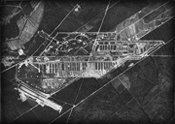Bergen - Belsen Timeline 1935 - Today
 Initially built to house construction workers building the nearby Bergen-Belsen (Now Bergen Hohne) Barracks, the camp saw many changes in it's lifetime. After the invasion of Belgium, Holland and France in 1940 it was used as a Prisoner of War (POW) Camp and was named Stammlager (Stalag) XI C/311.
Initially built to house construction workers building the nearby Bergen-Belsen (Now Bergen Hohne) Barracks, the camp saw many changes in it's lifetime. After the invasion of Belgium, Holland and France in 1940 it was used as a Prisoner of War (POW) Camp and was named Stammlager (Stalag) XI C/311.
The Stalag population increased dramatically in 1941 with the arrival of 20000 POW's from the East after the invasion of the Soviet Union, the majority of whom perished in the winter of 1941/42.
In 1943, after further development of the site an Internment camp was established for Jews who were intended for exchange for Germans held abroad. The POW's were removed to other Stalag's in the area and the POW camp became a hospital for sick Soviet POW's.
1944 and 1945 saw the camp population increase once more with the transfer of prisoners from other camps being evacuated due to the advances of the Allies.
In the weeks following liberation on 15 April 1945 the camp was evacuated, the survivors either allowed to return home or housed in a Displaced Persons Camp established by the British in Bergen-Belsen (now Bergen-Hohne) Barracks. All of the former prison blocks were burnt by 21 May 1945, leaving only the SS portion of the KZ remaining which was used to house refugees until 1953.
The timeline of Bergen-Belsen has been incorporated within a selective European timeline leading up to, during and after World War 2. Some of these events that have been included may, or may not, have had an effect on Bergen-Belsen. Additionally others have been included because Josef Kramer, the Kommandant, stated that the camp was not really inefficient until the Allies crossed the Rhein. From this information, the reader can formulate their own opinion.